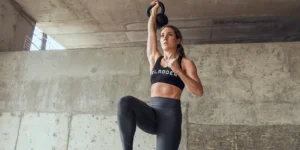
A founding coach at fitness app Ladder, Lauren Kanski’s diverse background and innovative techniques are shaping strength training and women’s health
Lauren Kanski has built a career dedicated to preventive healthcare and fitness. As the founding senior coach at Ladder, a strength training app that secured $12 million in funding last December, Kanski crafts personalized strength training programs with a focus on women’s health through her Body & Bell program.
Kanski’s journey began with a pre-med background and an eye-opening internship, where she recognized the need for more proactive wellness solutions. This realization led her to pivot towards fitness, gaining valuable experience and confidence at Equinox in New York City. There, she launched her own personal training business, working with high-profile clients and developing a unique approach to strength training.
A kettlebell specialist and NASM-certified personal trainer, Kanski advocates for the “hardstyle” kettlebell technique, which she integrates into her programs for maximum effectiveness. Her expertise also extends to pre/postnatal training, where she empowers women to stay active during pregnancy, debunking common myths and promoting healthy, science-backed practices.
Athletech News spoke with Kanski about her journey, her approach to dynamic strength training and how Ladder’s unique structure keeps clients engaged and motivated.
This conversation has been lightly edited for clarity and length.

Athletech News: Can you share the journey that led you to become the founding senior coach at Ladder?
Lauren Kanski: I was pre-med all through college. I wanted to go into plastic surgery and was very passionate about breast reconstruction for breast cancer patients. I spent my last two summers of undergrad interning for a plastic surgeon. It was then that I noticed how backward our healthcare system is and how people severely needed more preventive healthcare help.
So I didn’t go to med school but instead got an inside sales job right out of college. I learned how to sell myself and then started my own personal training business. From there, I went to Equinox in New York City where I got a great education and gained confidence in the training space.
I stepped back out on my own and ran around the city training very high-profile clients and worked out of a boutique gym, all private. I then met the Ladder team, and we developed what the app has become today.
ATN: What kettlebell techniques do you find most effective, and how do you integrate them into your training programs for optimal results?
LK: The shape of the kettlebell is what makes it unique. You can train strength, speed, endurance and power with one piece of iron if you know how to use it correctly. I help general population adults of all ages feel youthful and athletic, whether they are at the gym or in their living rooms.
The way I use kettlebells is called the “hardstyle” kettlebell technique. We use compensatory acceleration, which means we move weights as quickly as possible to generate the most force and power. It is one of the best strategies for muscle health and fat loss because it’s very low impact and you don’t need much time.
ATN: Your expertise includes pre/postnatal training. How do you tailor these programs to meet the specific needs of your clients, and what considerations should fitness professionals keep in mind when working with this demographic?
LK: The wildest thing about pregnancy is the misunderstanding and old wives’ tales people still believe that simply aren’t true.
Under most circumstances, women are not fragile during pregnancy. We are supposed to keep training and moving. I try to relay that message, always backed by science, but you don’t need to modify much of what you’re already doing. There will, of course, be plank and core exercises that you cannot do, but the foundation stays the same as far as resistance training goes. I tell my members to listen to their bodies because they will all have their own unique experience, but moving will only help with labor and is very beneficial for the baby.
ATN: With the rising popularity of strength training among women, what emerging trends and techniques are you seeing, and how can fitness professionals leverage these trends to better support their female clients?
LK: It’s nice to see strength training becoming popular, and mainly “heavy” strength training at that. I still think there is a stigma around heavy lifting making women “bulky” when that’s simply not true, and it’s actually the best thing they can be doing for their health. Pilates is becoming very popular again, as is running, but we cannot let women stray from resistance training. A well-rounded program that includes it all is great.

ATN: Consistency is crucial in fitness. How does Ladder’s structure and content help fitness professionals encourage long-term adherence and motivation among their clients?
LK: There are a couple of key differences that make Ladder unique.
First, the teams/communities — people behave differently in groups. There’s a natural friendly competitiveness that keeps people accountable. Everyone is also doing the same workouts, so they can come together to bond over that. Seeing people going through the same life stuff or having the same amount of kids or work stress but still getting workouts in gives people a confidence and encouragement that a coach never could.
Also, the functionality and structure are unique — it’s easy, the tech is motivating, the coaches are top-tier, and the workouts rock. We have a journal where members can log everything to measure their progress. Keeping streaks going and seeing your progress long-term is great motivation for adherence.
And lastly, the workouts are progressive — it’s never random. We program in six-week cycles that make it hyper-focused on goals and keep people engaged. There’s room for constant growth.
